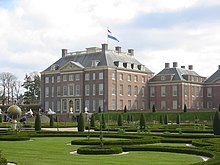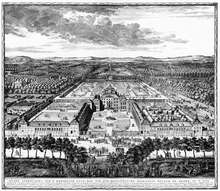Het Loo
The palace Het Loo ( German forest clearing castle) is a former royal castle northwest of Apeldoorn in the Netherlands . It is famous nationwide for its palace gardens.
History and architecture

The multi-wing, baroque palace was built between 1685 and 1692 by architects Jacob Roman and Daniel Marot near a 15th century moated castle, Kasteel Het Oude Loo . It served the Dutch governor Wilhelm III. , who went by the name of William III. From 1688 to 1701 was also King of England as a pleasure palace . The spacious baroque castle in brick construction became the model for many similar facilities in Europe, for example for Nordkirchen Castle in Westphalia .
After the childless death of Wilhelm III. 1702 inherited it, as well as the Huis ten Bosch in The Hague and the other private estates of the Orange, his first cousin and closest relative, King Friedrich I of Prussia, who through his mother, Luise Henriette of Orange , as well as his grandmother on his father's side, Elisabeth Charlotte von der Pfalz , descended from the House of Orange . His son Friedrich Wilhelm I , the soldier king, sold it in 1732 to Prince Wilhelm IV of Orange , who came from a distant branch of the Orange, the House of Nassau-Diez .
He and his descendants, today's Dutch royal family , then used the castle as a summer residence until 1975 . Queen Wilhelmina had already ceded it, including the crown domain, of over 10,000 hectares of land to the state, but on the condition that the property was returned in the event of the abolition of the monarchy. She retained the right of use at Kasteel Het Oude Loo and a partial area of 6750 hectares and the old castle is still used by the royal family as a family meeting place, while Princess Margriet had a house built on the edge of the park in 1970. Het Loo Castle is now a museum of the history of the Dutch royal family and also offers a glimpse of 300 years of princely living culture.
In 2018 the Stichting Restauratie Atelier Limburg (SRAL) took over the restoration of the pictures from the reception room and the private collection of Prince Bernhard .
garden
The garden can be reached from the castle via high, U-shaped convertible terraces . Around the palace there is a baroque garden , which is composed of two main and two side gardens and is decorated with large broderie beds , fountains, magnificent vases, statues and a colonnade . It is subject to a strict geometrical structure, the symmetry was consistently applied.
In the 18th century the facility was maintained as well as possible. Only the upper garden was repeatedly changed in a contemporary way. In the 19th century, the garden was turned into a landscape garden by filling it up. Excavations have been carried out since 1980 in order to reconstruct the garden in its original form. The result was a very detailed re-creation of the destroyed complex based on existing sources, but with the destruction of later conditions (landscape garden). The castle was declared a Rijksmonument .
Others
A model of Het Loo can be seen in the Madurodam miniature park .
Web links
- Official website (Dutch, German, English)
- Het Loo as a 3D model in SketchUp's 3D warehouse
Footnotes
- ↑ Wilhelmina : Lonely and yet not alone . Evangelisches Verlagswerk, Stuttgart 1961, p. 110.
Coordinates: 52 ° 14 '2.7 " N , 5 ° 56" 45.1 " E



